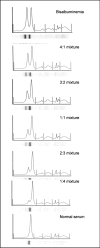Detection of hereditary bisalbuminemia in a Greek family by capillary zone electrophoresis
- PMID: 18923658
- PMCID: PMC2464307
Detection of hereditary bisalbuminemia in a Greek family by capillary zone electrophoresis
Abstract
It is presented herein a case of a family, four members of which suffer from hereditary bisalbuminemia. The abnormality was initially detected in a 29-year old male, by serum protein electrophoresis (SPE), during the investigation for possible multiple sclerosis. SPE also revealed the presence of a double albumin band in sera of the patient's sister, father and grandmother, almost confirming the inherited (genetic) form of bisalbuminemia. Possible causes related with the acquired form of bisalbuminemia were excluded for all examined individuals. SPE was performed by both automatic capillary zone electrophoresis and agaroze gel electrophoresis. All tested samples were immunofixated with special antisera, in order to exclude the presence of monoclonal fractions. Total albumin, total proteins and immunoglobulins varied in normal ranges. The relative mobility of the albumin variant was determined by a simple mixing experiment, which gave evidence of the fast-type form of inherited bisalbuminemia. This is the first report of hereditary bisalbuminemia in Greece.
Keywords: albumin; bisalbuminemia; protein electrophoresis.
Figures



References
-
- Hoang MP, Baskin LB, Wians FH., Jr Bisalbuminuria in an adult with bisalbuminemia and nephrotic syndrome. Clin Chim Acta. 1999;284:101–107. - PubMed
-
- Kobayashi S, Okamura N, Kamoi K, Sugita O. Bisalbumin (fast, slow type) induced by human pancreatic juice. Ann Clin Biochem. 1995;32:63–67. - PubMed
-
- Kurnit DM, Philipp BW, Bruns GA. Confirmation of the mapping assignment of human serum albumin to chromosome 4 using a cloned human albumin gene. Cytogenet Cell Genet. 1982;34:282–288. - PubMed
Publication types
LinkOut - more resources
Full Text Sources
